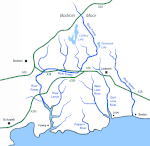Penpol Creek (River Fowey)
Cornwall geography stubsEngland river stubsRivers of Cornwall

Penpol Creek is a tidal creek which is a tributary of the River Fowey in Cornwall, England, UK. It lies between the parishes of St Veep and Lanteglos-by-Fowey. The tidal limit is at the bridge at lower Penpol. Penpol Mill is mentioned in 1591 and it was rebuilt in 1794, today it is abandoned. The bridge was built in 1867, replacing a tidal ford. Above the bridge the river becomes Trebant Water.
Excerpt from the Wikipedia article Penpol Creek (River Fowey) (License: CC BY-SA 3.0, Authors, Images).Penpol Creek (River Fowey)
Geographical coordinates (GPS) Address Nearby Places Show on map
Geographical coordinates (GPS)
| Latitude | Longitude |
|---|---|
| N 50.359 ° | E -4.6238 ° |
Address
PL22 0PB , St. Veep
England, United Kingdom
Open on Google Maps










